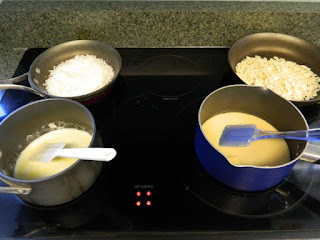I use as my overarching framework the notion of “learning through food,” i.e., learning about people and cultures through the foods they prepare and consume; the recipes which have been passed down, shared and adapted over time; and the meaning behind the meal. Situated within an ethnographic approach to food and a passion for "feeding the experience," I extend my foodie platform to include the cutting board, the in-between from farm to table. Bon appétit and ukonwabele ukutya kwakho!
Search This Blog
Sunday, 10 February 2013
ITKP: "Breaking the New Year Resolution: Chocolate Confections"
At the start of any new year, one of the most common resolutions is to lose weight. While there are many points of view in order to accomplish such a goal, one way is to cut out as much as sugar and dairy fats (e.g., cream and butter) as possible. For yesterday's practicum, the first of our second semester of the Food and Culture Colloquium, we delved into the complete opposite of cutting out foods from our diets and instead focused on simple desserts that require a cup of courage to look beyond the caloric count. On the menu: Brazil’s brigadeiro and France’s truffes au chocolat.
Just prior to the arrival of this practicum's participants, I got two pots and pans going on medium heat. In one pot, I prepped the ganache base for my recipe for chocolate truffles (so named for its close resemblance to the Black Truffles of France): 1/2 c heavy whipping cream and 2 & 1/2 T unsalted butter. Once the butter melted, I added 10 oz milk chocolate chips and off the heat allowed the heat of the cream and butter to melt them. Stirring until completely smooth, I finished off the ganache with 2 tsp vanilla extract.
In the second pot, I tried my hand for the first time in making brigadeiro, named after Brigadeiro Eduardo Gomes and guided by this recipe. In this pot, I heated one 14 oz can of sweetened condensed milk and 1 T unsalted butter. When the butter melted into the milk, I then stirred in 3 T baking cocoa powder and let this all cook together for about 10 minutes, breaking up as many cocoa clumps as possible as I stirred. As both pots were cooking away, I got some shredded coconut into one pan and sliced almonds in the other, keeping an eye on both until toasted (read: not burned). When the chocolate bases had finished cooking, I immediately transferred them over into separate bowls and into the fridge (and eventually the freezer) to chill quickly.
By this point, Daniel, Jasmine, Marilyn and eventually Chris arrived, and so we got going on making on-the-spot demo batches. After prepping a smaller batch of ganache for even more chocolate truffles (same process as above, but this time with 1/4 c heavy cream, 1 T unsalted butter and one 3.5 oz dark Lindt bar made up of 70% cocoa), we made a batch of brigadeiro base. In an attempt to reduce the cocoa clumps, I tried to sift the 3 T dark cocoa powder for this batch, but eventually quit in favour of just heating the milk and butter until slightly thinned and smooth, and then quickly stirring in the rest of the unsifted cocoa. In retrospect, using a strong whisk should do the trick.
For whatever reason, the longer coking time seemed to yield a better consistency in terms of developing a chewier caramel base (due to the milk's high sugar content), though I'm equally convienced the first batch worked better because it had a longer time to try and set. Whatever the procedure, the biggest take away is to give both the ganache and brigadeiro bases as much time as possible to set (anywhere from 2-4 hours to overnight is best, either in the fridge or at room temp); if you set these in the fridge overnight, give them about 15 minutes at room temperature to make them easier to scoop and handle.
Eventually, the ganache set much more quickly and so we began shaping and coating the truffles using a variety of ingredients: powdered sugar, sprinkles, coconut, crushed almonds and dark cocoa powder.
Though not perfectly set, we then moved onto the brigadeiro, making sure to first coat our palms with butter to prevent the mixture from sticking to our hands.
As each batch was completed, I transferred them into the sun room of The Open House to further chill and set. And after our fourth batch (and with a rough estimate of about 80+ pieces of chocolate made throughout the practicum), we made our way to the sun room to enjoy a serving (or four) before heading out to enjoy the rest of the chilly--yet sunny--day.
For more information regarding the 2012-2013 Food and Culture Colloquium at Denison University, click here. For the complete album from this practicum, click here. Colloquium lectures and practicums are open to all Denison faculty, staff and students, as well as area community members in and outside of Granville.
Subscribe to:
Post Comments (Atom)








No comments:
Post a Comment